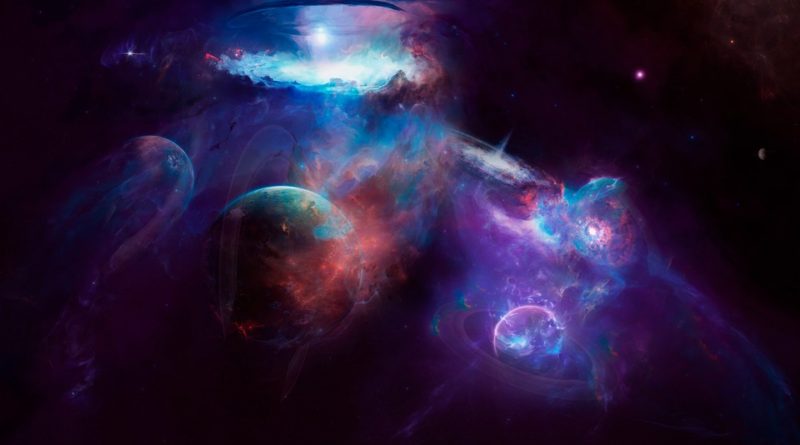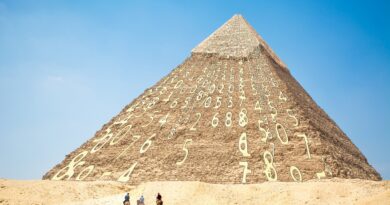The Ancient Cosmic War of Genesis 1—Chaoskampf—and the Coming Antichrist
By Derek Gilbert
Everything has a start. A plant, a person, an idea. Even the universe had a beginning.
In Genesis, chapter 1, we’re told that God created the heavens and the earth. Then, only two verses in, we read something that may not make sense when we first read it, because something happened to the earth. Rather than being described as “good” and perfect, as we see in later verses regarding creation, our world is described as “void” and “without form.” Now, why would God create something that’s basically unfinished?
Simple answer: He didn’t.
It’s our belief that the Lord created everything in perfect condition, but that something catastrophic occurred between verses 1 and 2 that so scarred the original creation it rendered the earth “void” and “without form.” We believe that “something” was a cataclysmic rebellion, led by a primordial being we refer to as “Prisoner Zero.” Scholars have named this conflict the Chaoskampf: an ancient war that formed the pattern for what’s to come in our future. To understand the end times and the book of Revelation, we must understand the Chaoskampf, for it is the history of a long, spiritual war that will one day end with a new heaven and a new earth: A return to a pristine, former glory. The end from the beginning—the beginning from the end.
As God promises in Isaiah 46:11, “I have spoken,” says Yahweh. “I will bring it to pass. I have purposed it, and I will do it.” What does He mean by this? What is God vowing to accomplish? What ancient prophecy awaits final fulfillment? That question requires some time to unpack, for it’s one of those frequently “missed” prophecies that, as with Poe’s Purloined Letter, has been staring us in the face the entire time. But its form and shape emerge once we take the Bible as a whole and realize that Revelation cannot be understood without first discerning the implications of Genesis.
The end from the beginning. A series of rebels and rebellions.
Prisoner Zero. The Chaos Dragon. The Nachash. The Watchers. The Nephilim. Babel. Satan. The Antichrist.

Most of you are familiar with the prophecy of Ezekiel 38, where we read that Gog leads a confederation against Israel. His objective will be Zion, the har môʿēd, God’s mount of assembly. Gog comes from the north, but “north” in this case is not so much a geographic direction as it is spiritual north, consistent with the Jewish tradition of evil always descending upon Israel from “the north.” Historically, the most fearsome enemies always attacked from that direction, mainly Assyria, Babylon or the Arameans. Crossing the Syrian desert to the east was foolish.
Likewise, supernatural threats to Israel also came from the north: Bashan, the entrance to the Canaanite underworld; Mount Hermon, El’s mount of assembly and the site of the Watchers’ rebellion; and Mount Zaphon, the home of Baal’s palace, were all located to the north of Israel. This is the proper context for viewing the war of Gog and Magog depicted in Ezekiel 38 and 39, because the phrase in Ezekiel translated “uttermost north” (and “sides of the north” in Isaiah 14:13) is yarkete tsaphon. The prophets pointed to a place, not a direction.
Gog is the personal name of a Reubenite, but it’s also the name of a spirit entity, that which animates Antichrist, the great supernatural end-times enemy of God and Israel. Speculation linking the identity of Gog to any Russian leader is misguided. First, while there may be Russians in the coalition that comes to Jerusalem for the Battle of Armageddon, Russia as a nation is not part of Ezekiel’s prophecy. With all due respect to Bible teachers who hold the “Russia is Magog” view, identifying Rosh as Russia and Meshech as Moscow is folk etymology, making connections simply because the words soundthe same. Language doesn’t always work like that. For example, “dear” and “deer” sound the same, but you won’t mistake your spouse for Bambi.
More importantly, the grisly sacrificial feasts of Ezekiel 39:17–20 and Revelation 19:17–21 confirm that the war of Gog ends at Armageddon. It’s the same conflict. So, unless we create a plausible scenario that includes a Russian Antichrist, we have to let that theory go.
We can agree, however, that the Beast emerging from the sea in Revelation 13:1 is the Antichrist figure, but did you know this relates back to Prisoner Zero? The sea (Yam in Hebrew) is most properly understood as an entity. Yam is a proper name and represents Chaos, the very rebel that God subdued in the first two verses of the Bible.

In the beginning, God created the heavens and the earth. The earth was without form and void, and darkness was over the face of the deep. And the Spirit of God was hovering over the face of the waters. (Genesis 1:1–2)
The Hebrew word translated as “deep” is tehom, which is a cognate—that is, the same word in a different language—to the Akkadian Têmtum, which, in turn, is a variant of Tiamat, the Sumerian chaos monster who was defeated by the warrior god, Marduk, to bring order to creation. Similar myths were common in the ancient Near East (ANE): Baal vs. Yamm, Teshub vs. Illuyanka, Zeus vs. Typhon.
But the original version is Yahweh vs. Leviathan.
Now, the most obvious difference between the biblical account and the others is that the fight between God and Chaos, if there was a fight, was over by the end of the second verse in the Bible. We see references to it in later chapters (for example, Psalm 74:12–17), but there is no hint that God had any trouble bringing Chaos to heel. He merely placed His Spirit over the deep and it obeyed. “Down! Stay!” No weapons needed. Just His Word.
Not so with pagan versions of this epic moment in history. In every case, the warrior god required outside help, weapons, and multiple battles to subdue the sea monster representing Chaos. But Chaos, being a supernatural creature, is (for the present) only restrained, not dead.
Now, here’s where Typhon comes in.
According to the Greek poet Hesiod, Zeus threw the serpentine chaos-monster Typhon into Tartarus to share a cellblock with the infamous Titans. We can be reasonably sure the Titans/Watchers are presently in Tartarus. Hesiod and Homer agreed on that point, and Peter confirmed it (see 2 Peter 2:4, and note that the Greek word translated “Hell” is tartaroo—Tartarus).

The Greeks believed the battle between Zeus and Typhon took place at Mount Kasios, which was their name for Baal’s holy mountain, Zaphon. Scholars have long noted that Typhon’s name resembles Zaphon so closely they are most likely etymologically linked. This gives us a clear connection between Zaphon, the mountain where the Antichrist/Gog will marshal his forces, and the chaos-god Typhon. And while this entity is called a dragon (with a hundred heads no less!) by Hesiod, Typhon is described elsewhere as “a hybrid between man and beast,” with many wings, coils of vipers for legs, and a human head. That is, the Greek god of chaos was a human-animal chimera, similar to the way ancient Mesopotamians described the apkallu, who were—yep, you guessed it—the Watchers/Titans.
In other words, the Greeks remembered that a monstrous deity connected to Satan/Baal’s mount of assembly, Zaphon, was buried in Tartarus—the abyss, which is represented in the Bible by the sea. In Revelation, the Beast, which is described as a chimeric entity like the chaos-monster Typhon, emerges from the sea (Yam)—the abyss—to become the Antichrist (Gog) and lead the war against God’s holy mountain, Zion:
Then the dragon became furious with the woman and went off to make war on the rest of her offspring, on those who keep the commandments of God and hold to the testimony of Jesus. And he stood on the sand of the sea.
And I saw a beast rising out of the sea, with ten horns and seven heads, with ten diadems on its horns and blasphemous names on its heads. (Revelation 12:17–13:1)
The verses above suggest that it is the dragon who stands on the shore when the Beast, the Antichrist/Gog, rises from the abyss. Please note that Satan/Baal’s mount of assembly, Zaphon, today called Jebel al-Aqra, sits on the shore of the Mediterranean Sea.

All that leads to the $64,000 question: Could the Antichrist actually be the spirit of Chaos, known also as Leviathan, Tiamat, Têmtu, and the Dragon?
Yes.
Now, while the chaos-god Typhon wasn’t one of the original Titans, he was believed to be their half-brother and is sometimes referred to as a Titan. Interestingly, at least one of the early church fathers thought a Titan would return at the end of days. Irenaeus, a Christian theologian of the second century, offered these thoughts on John’s prophecy of the Antichrist:
Although certain as to the number of the name of Antichrist, yet we should come to no rash conclusions as to the name itself, because this number [666] is capable of being fitted to many names.… Teitan too, (ΤΕΙΤΑΝ, the first syllable being written with the two Greek vowels ε and ι), among all the names which are found among us, is rather worthy of credit… Inasmuch, then, as this name “Titan” has so much to recommend it, there is a strong degree of probability, that from among the many [names suggested], we infer, that perchance he who is to come shall be called “Titan.” (Emphasis added)
To his credit, Irenaeus declined to say absolutely that the Antichrist would be named Titan. He reasoned that if the precise name had been important, John would have revealed it instead of a number. Still, it’s intriguing, isn’t it? And consider this: Jesus demonstrated His mastery over Chaos to the disciples one night on the Sea of Galilee:
On that day, when evening had come, he said to them, “Let us go across to the other side.” And leaving the crowd, they took him with them in the boat, just as he was. And other boats were with him. And a great windstorm arose, and the waves were breaking into the boat, so that the boat was already filling. But he was in the stern, asleep on the cushion. And they woke him and said to him, “Teacher, do you not care that we are perishing?” And he awoke and rebuked the wind and said to the sea, “Peace! Be still!” And the wind ceased, and there was a great calm. He said to them, “Why are you so afraid? Have you still no faith?” And they were filled with great fear and said to one another, “Who then is this, that even the wind and the sea obey him?” (Mark 4:35–41; emphasis added)

Puts that story in a whole different light, doesn’t it?
Now, let’s look at Revelation 9. When the fifth of the trumpet-blowing angels sounds his horn, a star falls from heaven to earth with a key to the abyss. We believe that this moment marks the return of the old gods:
He opened the shaft of the bottomless pit, and from the shaft rose smoke like the smoke of a great furnace, and the sun and the air were darkened with the smoke from the shaft. Then from the smoke came locusts on the earth, and they were given power like the power of scorpions of the earth. They were told not to harm the grass of the earth or any green plant or any tree, but only those people who do not have the seal of God on their foreheads. They were allowed to torment them for five months, but not to kill them, and their torment was like the torment of a scorpion when it stings someone. And in those days people will seek death and will not find it. They will long to die, but death will flee from them.
In appearance the locusts were like horses prepared for battle: on their heads were what looked like crowns of gold; their faces were like human faces, their hair like women’s hair, and their teeth like lions’ teeth; they had breastplates like breastplates of iron, and the noise of their wings was like the noise of many chariots with horses rushing into battle. They have tails and stings like scorpions, and their power to hurt people for five months is in their tails. They have as king over them the angel of the bottomless pit. His name in Hebrew is Abaddon, and in Greek he is called Apollyon. (Revelation 9:2–11; emphasis added)
In the preceding verses, we see the entities that the world thousands of years ago called Titans, Watchers, Anunnaki, and even apkallu angrily roar out of the abyss. That’s where they are now, but they’ll soon be given a short time to torment humanity. Five months. One hundred and fifty days—the same it took for their children, the Nephilim, to die in the Flood!

Thus, the Watchers will take revenge on God’s most prized creation—man—in return for the punishment of watching their own children, the Nephilim/Rephaim, destroyed in the Flood of Noah. Granted, the description of the things from the pit doesn’t exactly match the Mesopotamian images of apkallu or Greek sculptures of the Titans. Remember, though, that those entities were sent to the bottomless pit around the time of the Great Flood. Hundreds of years, and maybe a thousand or more, had passed by the time the Sumerians began to create images of apkallu on cylinder seals and clay tablets. Those descriptions captured handed-down, oral traditions of supernatural human-animal hybrids, however, which is basically what John describes for us in Revelation.
The Titans, the Watchers of the Bible, return when Apollyon opens the pit. And for humans without the protective seal of God on their foreheads, it will literally be hell on earth.

Derek P. Gilbert hosts Five in Ten, a daily analysis of the news for SkyWatchTV, and co-hosts the weekly programs The Bible’s Greatest Mysteries and Unraveling Revelation with his wife, author, and analyst Sharon K. Gilbert. Derek is a Christian, a husband and father, and the author of the groundbreaking books Bad Moon Rising, an analysis of the spiritual forces behind Islam, The Great Inception, and Last Clash of the Titans. He’s also the co-author with Sharon K. Gilbert of Giants, Gods & Dragons, a new take on end-times prophecy that names the Four Horsemen of the Apocalypse, and Veneration, a deep study on the ancient cult of the Rephaim. Derek has also co-authored The Day the Earth Stands Still with Josh Peck, which documents the occult origins of “ancient aliens.” Derek’s new book is The Second Coming of Saturn, which exposes the many faces of the Roman god Saturn and his role during the end times. Find out more at www.derekgilbert.com, www.gilberthouse.org, or www.SkyWatchTV.com.



